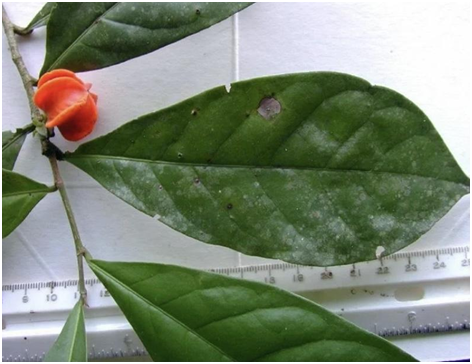Finally, after half a decade, the plant’s origin was discovered and it was given a name.
In 1973, a strange plant was discovered by Scientist Robin Foster in the Amazon rainforest. This plant was around 20 feet tall, with tiny orange shaped fruits which looked like paper lanterns.
He had never seen something so strange, so he collected few samples to research about this strange plant, but unfortunately, all the scientists he showed weren’t able to identify this plant or its origin.
They couldn’t even declare this plant as a new species because they didn’t know which family it belonged to, and hence it became extremely difficult to identify this mysterious plant.
When I first saw this little tree, while out on a forest trail leading from the field station, it was the fruit — looking like an orange-coloured Chinese lantern and juicy
When ripe with several seeds — that caught my attention,” says Robin Foster, the scientist who originally collected the mystery plant in Peru’s Manu National Park,
A retired curator at Chicago’s Field Museum and now a researcher with the Smithsonian Tropical Research Institute.
He thought it wasn’t something special except that the plant had characteristics of plants in several different plant families and didn’t completely fall into any plant family.
She said that Nancy Hensold, a botanist at the field Museum, couldn’t find out about this plant.
Thirty years back, Foster had bought the dried sample, and she tried to get it identified by boiling its ovaries and taking pictures of the pollen. But unfortunately, even she couldn’t discover the plant.
After half a century, finally, it has been classified as ‘Aenigmanu Alvareziae’
According to a paper authored by Foster, it’s stated that the mystery of Manu has been solved after fifty years, and the plant has been named ‘Aenigmanu Alvareziae’ finally.
It took nearly half a decade to name and find this plant as it couldn’t be delivered to the right specialist.
Due to the plant’s characteristics, it could be placed into multiple categories, so it became more difficult for scientists to find the precise species from where it belonged.
The research team could not analyse the plant DNA because its specimen had dried, and conducted a DNA test with the dried specimen was an impossible task to do.
But in 2015, a scientist named Patricia Álvarez-Loayza collected some fresh samples to analyse the plant.
It was discovered that the plant was a part of the Picramniaceae family, which is a small family of plants from western hemisphere tropics and subtropics.
Until a plant is classified, it doesn’t exist, said Martin Cheek, a senior research leader in the accelerated taxonomy department at the Royal Botanic Gardens in London.
The researchers also said now that the plant is finally classified would help protect the Amazon rainforest in the face of deforestation and climatic change.
With the classification of the mysterious plant, scientists and researchers are now planning to work on its features and its beneficiary uses to humankind.
As it is classified as the ‘Picramniaceae’ family, the scientists are looking for its anti-cancer properties, which are a speciality of this plant family.
Hensold said that the orange-like fruits of the plants could not become a good food source for humans because the seeds are too large without much flesh.
The fruit tastes creamy and sweet said, Patricia.
As now the mystery is finally solved, the plant has been classified as ‘Picramniaceae’, after nearly half a decade that is around fifty years, all the scientists and researchers are set to find its properties and uses for it to be used as something beneficial in the future.













